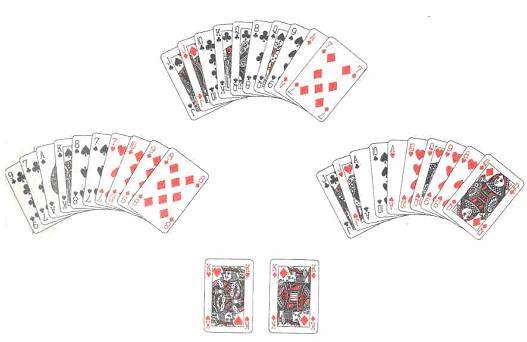Requirements to bid a suit contract. The important cards are Jacks and Aces, and the average reading hand has 1⅓ of each of them. The advantages of getting the skat, discarding, and choosing trumps almost outweight the disadvantage of being one player against two, and most hands with three cards which are Jacks or Aces can reasonably be bid up to the value of their lowest ranking long suit.
To bid grand. Here Jacks and aces are especially important. Normally you need five of them (or perhaps four if your are Forehand, and have the lead ). Tens to support your Aces are much better than 10s by themselves.
To bid null. You need 7s. competent defenders will nearly always force you to take a trick if you have a three-card suit containing the Ace or King, or a four-card suit missing the 7, or a single card of a suit which is not 7, 8 or 9.
Going in hand. If you have a rock-crushing collection of Aces and Jacks you might as well go in hand to score for the extra multiplier, but there are two common reasons for the extra multiplier, but there are two common reasons for not doing so:
a holding which is almost sure to make game in hand can be converted, using the skat, to one which is absolutely sure to make game and almost sure to make Schneider the extra multiplier for Schneider is just as good as the one for poker hand, and you are insured against dangers like a 5-o trump split.
Many holdings which would make game in hand in a suit could be converted into a grand given one more Ace or Jack from the skat. Since grand is so much more valuable than the suit contracts it is often worth forgoing the multiplier for hand in the hope of something bigger. If there are four particular cards any one of which would let you make grand, the chance of finding one of them in the skat is about one in three.
Discarding the skat. The declarer should try to create void suits where he hold one or two cards without the Ace. One odd low card can cost 21 card points. It is much better to have two low cards in one suit than one in each of two suits. Never discard an Ace.
Counting. Counting is quite important in Skat. If you can only remember one number, then count trumps. If you can manage two, then count trumps and the number of card point the defenders have collected.
Choosing trumps. If you have two suits of equal length, then choose the weaker one as trumps, which avoids devaluing your Aces.
The following example hand (see illustration ) covers a number of other aspects of skilful play you may find it easier to follow by laying the cards out on a poker table.
First’s let’s consider what the players should be prepared to bid:
Forehand: He has no chance in anything except null. His clubs and hearts are safe, but he might be forced to take a trick either in spades or diamonds (the diamonds are about as worrying as the spades any long suit missing the 7 is a liability in null). He has a reasonable chance of improving one or both these suits if he looks at the skat, so he can bid up to 23.

Middlehand: He has a reasonable hand for playing in clubs (he can even consider playing in hand ) but he would feel much happier if he could see the skat, and find another club, or a Jack, or an Ace. He can bid up to 24 (clubs without one).
